

| Online: | |
| Visits: | |
| Stories: |

| Story Views | |
| Now: | |
| Last Hour: | |
| Last 24 Hours: | |
| Total: | |
Learning Makes Animals Intelligent
Animals are often very effective; an oystercatcher opens mussels quickly, a baboon takes every opportunity to steal food from tourists or a rat navigates with ease between the bins in a park. Previously these behaviours have been considered to be inherited instincts, even though it is well known that animals have great learning abilities.
An orangutan builds an umbrella against the rain. Efficient and intelligent behavior that can be explained by new research from Stockholm University and Brooklyn College.
Researchers from Stockholm University and Brooklyn College have now created an associative learning model that explains how effective behaviours can arise. This means that an animal does not only learn that the last step of a behaviour chain, the one that is rewarding, is valuable. An animal can learn that all steps towards the reward are valuable.
A pigeon takes the subway instead of flying. Efficient and intelligent behavior can be explained by new research from Stockholm University and Brooklyn College.

Photo: Johan Lind/N.
Since the 1970s it has been known that animals weigh the cost of a certain behaviour against the profit and that they, to a high degree, make optimal decisions, which is assumed to be genetically determined. The research group’s new model deals not only with learning, it also takes into account the idea that what animals are able to learn can be genetically regulated.
“Young animals are often a bit clumsy, while adult animals are extremely skilled. A small cub does not even consider a vole as food, while an adult fox is an expert vole catcher”, says Johan Lind associate professor of ethology at Stockholm University. “Our model shows how genetic regulation of learning can influence the development of species-specific behaviour and intelligence since evolution can affect curiosity and the speed of learning among other things.”
The researchers’ new model could also explain counterproductive behaviour in artificial environments.
“Many learning models can explain optimal behaviour, but to explain counterproductive behaviour an understanding of the mechanisms of the behaviour is needed. Using our model, we manage to explain why animals get stuck in suboptimal behaviour. Like a hamster running in its hamster wheel despite having food next to it. Our model has captured fundamental aspects of learning”, says Stefano Ghirlanda, professor of psychology at Brooklyn College in New York.
The learning model and the research results were recently published in the journal Royal Society Open Science (“The power of associative learning and the ontogeny of optimal behavior”). [link]
Contacts and sources:
Magnus Enquist, professor of ethology at Stockholm University
Source:



